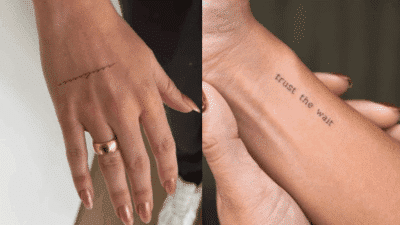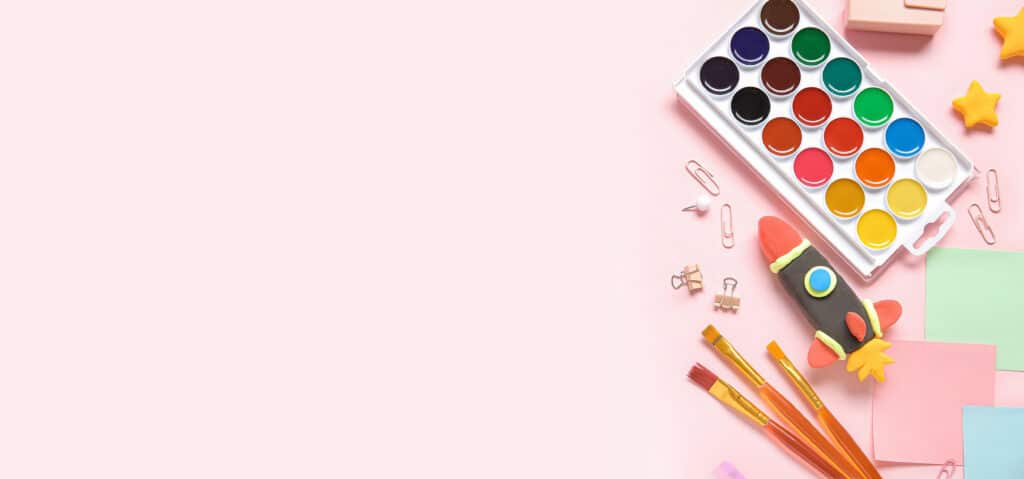
Creative platforms offer much more than a place to show your work. Some are built for learning new techniques while others bring together artists and clients or help you sell your latest piece. The way each platform combines inspiration, learning, connection, and opportunity reveals something unique about what helps creativity grow online. Whether you are building a career or just exploring new ideas it is surprising how different each space can feel. The features, community, and focus of each platform can make all the difference when you seek a home for your creative journey.
Table of Contents
- Sky Rye Design
- ArtStation
- Behance
- Dribbble
Sky Rye Design
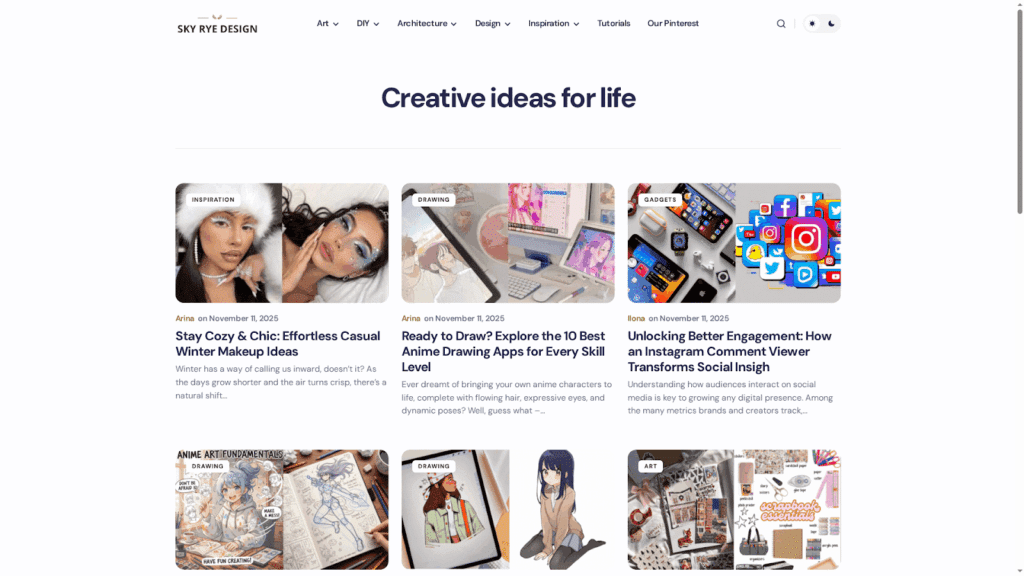
At a Glance
Sky Rye Design is a content-first platform that curates online magazines focused on art, design, and everyday creativity. It delivers a steady stream of tutorials, inspiration, and practical ideas for drawing, interior architecture, fashion, and seasonal projects, making it a dependable source for creative sparks. While it doesn’t sell products directly or advertise interactive community tooling, that editorial focus is a deliberate strength: clean, inspiration-rich content without clutter. Read it when you need instruction, ideas, or a fresh creative angle.
Core Features
Sky Rye Design offers a rich collection of articles and tutorials that cover drawing techniques, interior design concepts, and broader creative life ideas. Content is updated regularly across diverse topics—from digital drawing apps and anime sketch guides to festive art projects and fashion-inspired visuals. The site emphasizes practical tutorials alongside inspirational essays, and it deliberately engages arts and design communities by offering educational material suitable for beginners through advanced creators.
Pros
- Wide topical range: Sky Rye Design provides a wide range of articles and tutorials that span art, interior design, and creative lifestyle topics, so you’ll find both technique and inspiration in one place.
- Consistently refreshed content: The site is updated regularly with fresh posts, ensuring new ideas and tools appear often enough to keep your practice evolving.
- Skill-level inclusivity: Articles address different levels of ability, meaning beginners and more advanced artists both find immediately useful guidance.
- Digital tool coverage: Sky Rye Design includes focused content on digital drawing apps and tools, helping artists bridge analog technique and digital workflow.
- Inspiration-forward editorial voice: The curated articles and seasonal projects are designed to spark creative projects and practical home or fashion experiments.

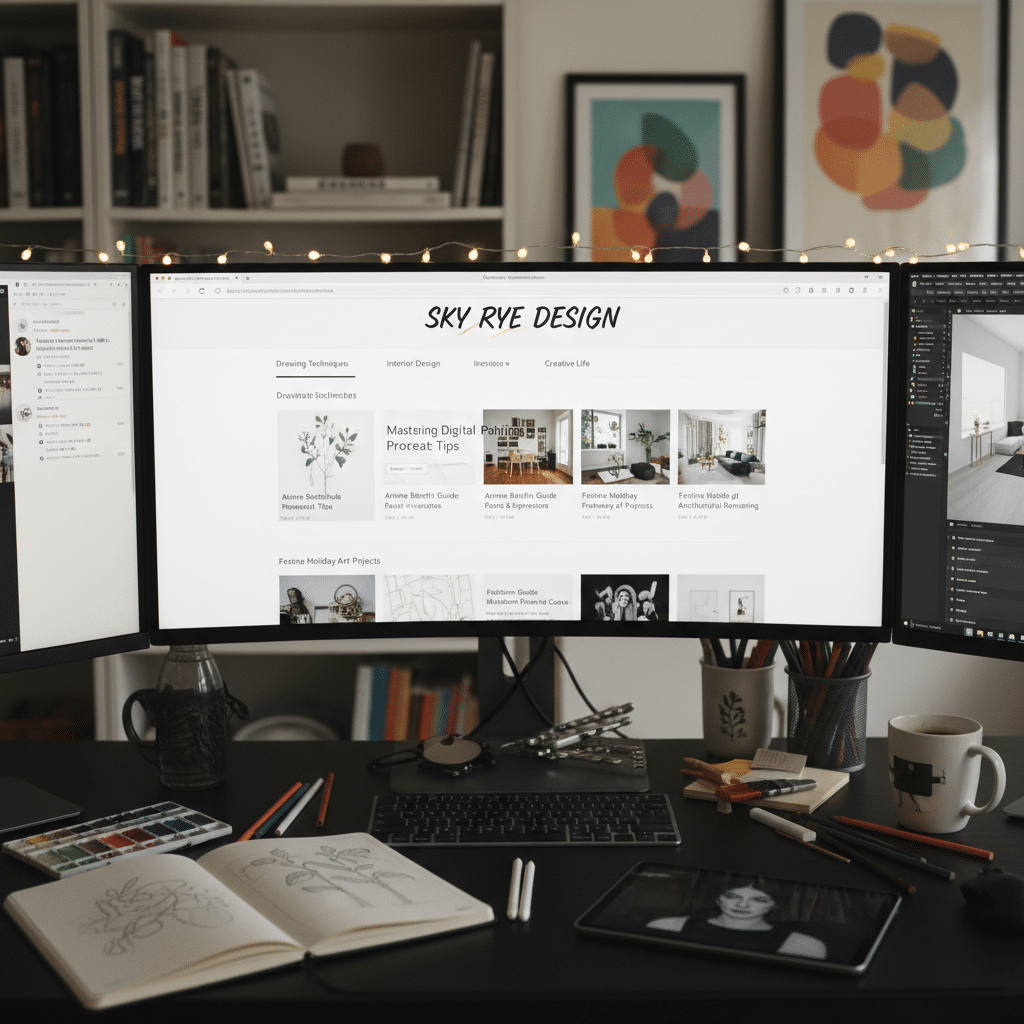
Who It’s For
Sky Rye Design is ideal for art and design enthusiasts, hobbyist creators, and professional designers seeking ongoing inspiration and technique refreshers. If you’re a homeowner planning a creative renovation, a UI/UX designer looking for visual direction, or a hobbyist seeking new sketching tutorials, this site supplies approachable guidance and curated ideas. It’s also tailored to those who prefer editorial guidance over marketplace noise.
Unique Value Proposition
Sky Rye Design’s unique value lies in its singular editorial focus: curated, education-driven content that connects art, design, and everyday creative living. Unlike platforms that mix heavy commerce or noisy community features, Sky Rye Design prioritizes high-quality tutorials and thematic inspiration across drawing, interior architecture, fashion, and seasonal projects. That clarity of purpose creates a superior browsing experience for creatives who want depth without distraction. Its regular updates and inclusive skill-level approach mean you won’t outgrow the site quickly; it functions as a creative library that fuels both learning and project-ready ideas, positioning it above competitors that either fragment content or prioritize sales over substance.
Real World Use Case
A sketching student wants to improve anime character work and learn which digital apps fit their workflow. They can read step-by-step tutorials, compare featured drawing apps, and try seasonal projects suggested on Sky Rye Design—then apply those techniques to portfolio pieces or home decor concepts.
Pricing
Not specified on the website.
Website: https://skyryedesign.com
ArtStation
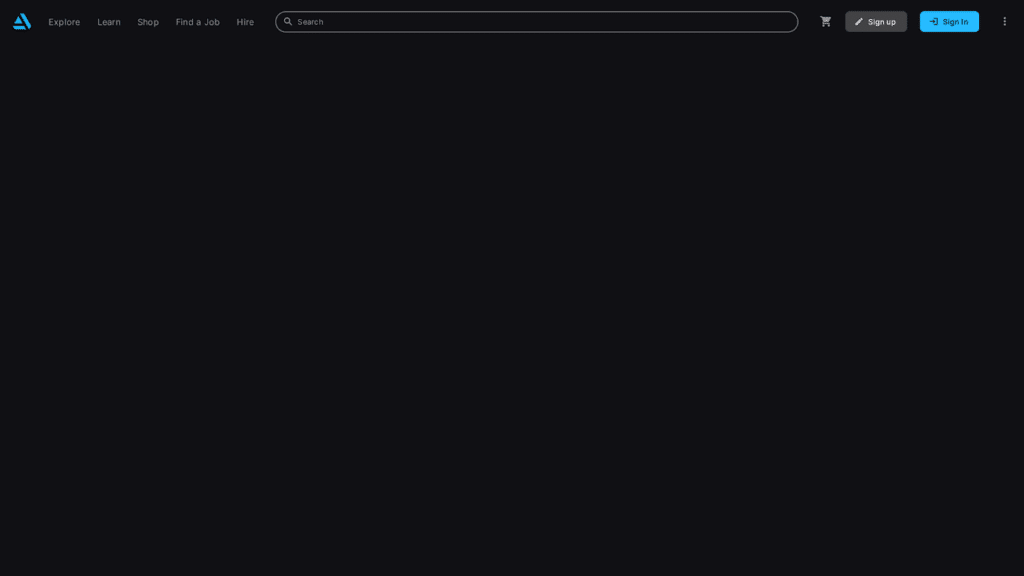
At a Glance
ArtStation is a widely recognized showcase and marketplace built for artists and designers who want visibility and commercial opportunities. It combines portfolio hosting with a marketplace and event-driven sales like the Spring Fling sale, giving creators multiple ways to display and monetize work. The platform supports streamlined sign-in options and adapts currency based on location, which lowers friction for international users. Bottom line: it’s a full-featured hub for getting work seen and sold, though some product details and regional limitations may require extra investigation.
Core Features
ArtStation centers on portfolio presentation and commerce: creators can build visual showcases, list art and related products in a marketplace, and participate in timed sales and promotions such as Spring Fling. Sign-in is flexible, offering Epic Games, Google, Facebook, or traditional email/password access to simplify onboarding. Currency localization customizes the shopping experience for buyers and sellers based on their location, helping transactions feel native. Together these elements form a platform focused on both discovery and direct sales.
Pros
- Popular platform for exposure: ArtStation’s reputation makes it an effective place for artists to showcase work and reach a large creative audience.
- Multiple sign-in options: Having Epic Games, Google, Facebook, and email/password logins reduces friction and lets users choose a convenient authentication method.
- Localized currency options: Automated currency localization helps buyers understand prices without manual conversion and supports smoother international sales.
- Marketplace plus event sales: The combination of a permanent marketplace and periodic events like Spring Fling gives artists recurring opportunities to sell work and merchandise.
- Comprehensive display and sales focus: The platform’s dual emphasis on visual presentation and commerce makes it useful for creators who want both a portfolio and a storefront.
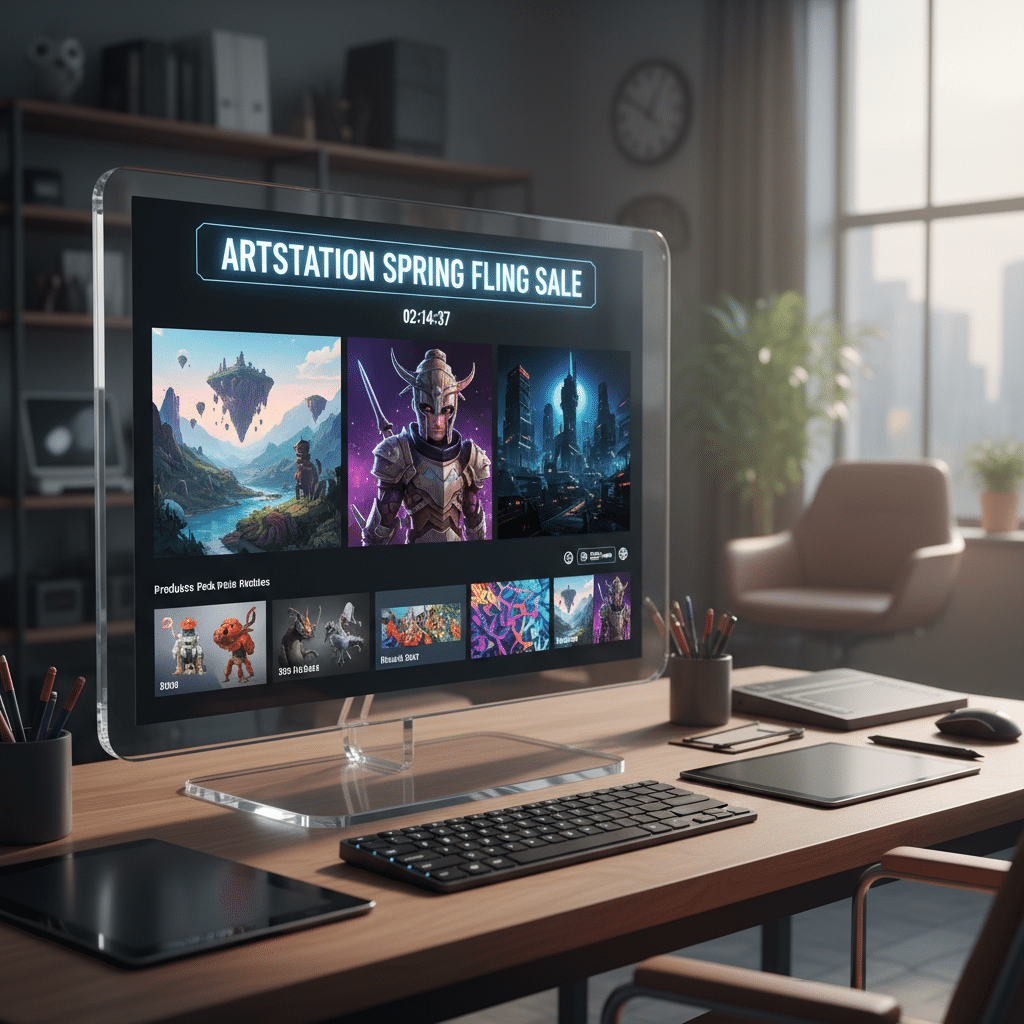
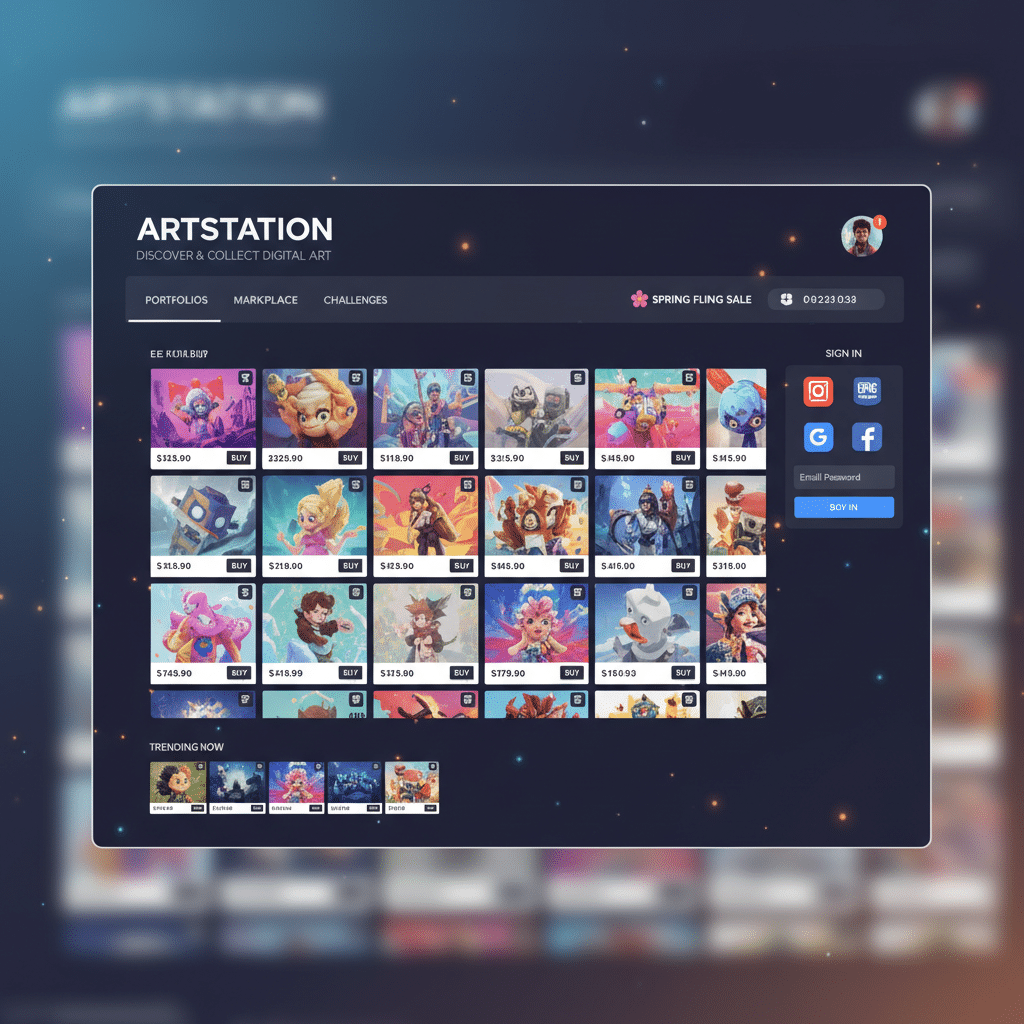
Cons
- Limited public product detail: The available content shows only high-level platform functions, so specific feature details and workflows aren’t clearly documented from the provided source.
- Possible regional restrictions: Some features or content may be limited by region, which could affect access to events, payment options, or marketplace listings.
- Onboarding may be long for some users: Although multiple sign-in options exist, the sign-in and setup process may feel lengthy for new users compared to very lightweight portfolio builders.
Who It’s For
ArtStation is ideal for professional and emerging artists, illustrators, 3D artists, and designers who want to present polished portfolios while retaining direct selling options. It also serves art buyers and enthusiasts who prefer browsing curated portfolios and participating in sales events.
Unique Value Proposition
ArtStation uniquely blends portfolio showcasing with a commerce-ready marketplace and event-driven promotions, providing a single ecosystem where discovery and sales coexist. That integration helps artists turn visibility into revenue without juggling separate services.
Real World Use Case
An artist builds a portfolio on ArtStation to display character art and concept pieces, lists prints and digital assets in the marketplace, and joins the Spring Fling sale to reach seasonal buyers and move inventory.
Pricing
Not specified in the provided content.
Website: https://artstation.com
Behance
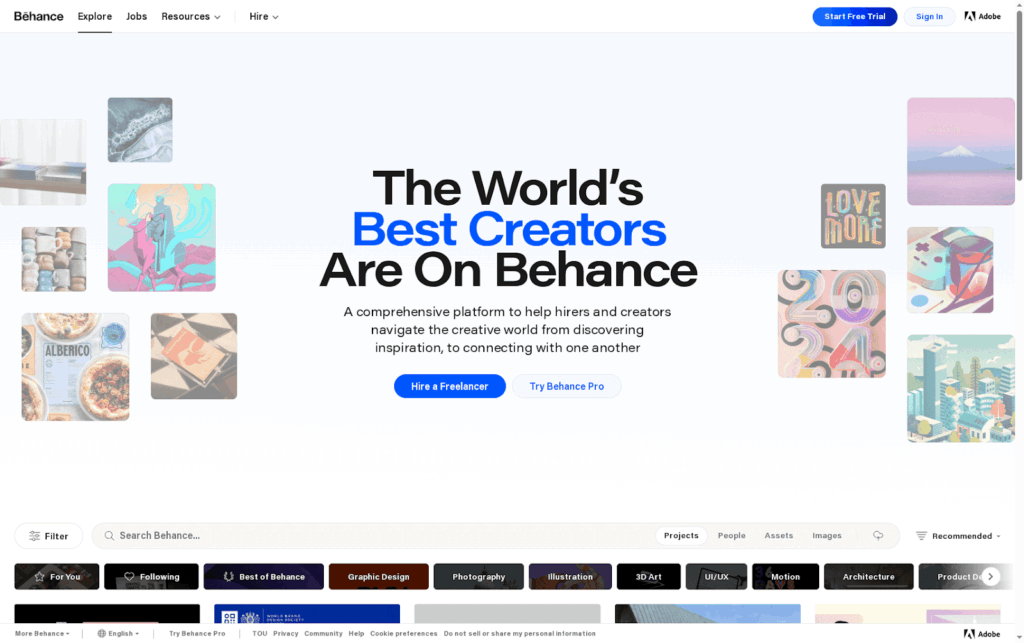
At a Glance
Behance is a visually driven marketplace and discovery platform where creatives display projects, find inspiration, and connect with potential clients. It’s especially valuable for designers, photographers, and illustrators who want a gallery-style presentation with category-based discovery and community feedback. The platform can feel crowded, but its reach and visual polish make it a practical hub for showcasing work and attracting freelance opportunities.
Core Features
Behance lets you showcase creative work across multiple fields, discover and search portfolios and projects, connect with other creatives, and hire freelancers directly. It surfaces curated collections such as most appreciated, most viewed, and most discussed projects to help users find trending work, and it integrates with Adobe Creative Cloud to streamline publishing for Adobe users.
Pros
- Extensive creative network: Behance hosts a broad community of creators and projects, which increases the chance your work will be discovered by peers and hirers.
- Wide range of categories: The platform covers many creative fields, so you can position niche work alongside more mainstream disciplines and reach relevant audiences.
- Hiring and collaboration opportunities: Behance supports direct hiring, making it possible to convert portfolio exposure into paid projects without leaving the platform.
- Strong visual presentation: Portfolios are displayed with emphasis on imagery and layout, helping projects look polished and easy to browse.
- Adobe Creative Cloud integration: Direct integration with Adobe tools simplifies uploading and maintaining projects for creators who already work in that ecosystem.
- Active community engagement: The platform encourages appreciation and discussion, which can generate constructive feedback and inspiration.
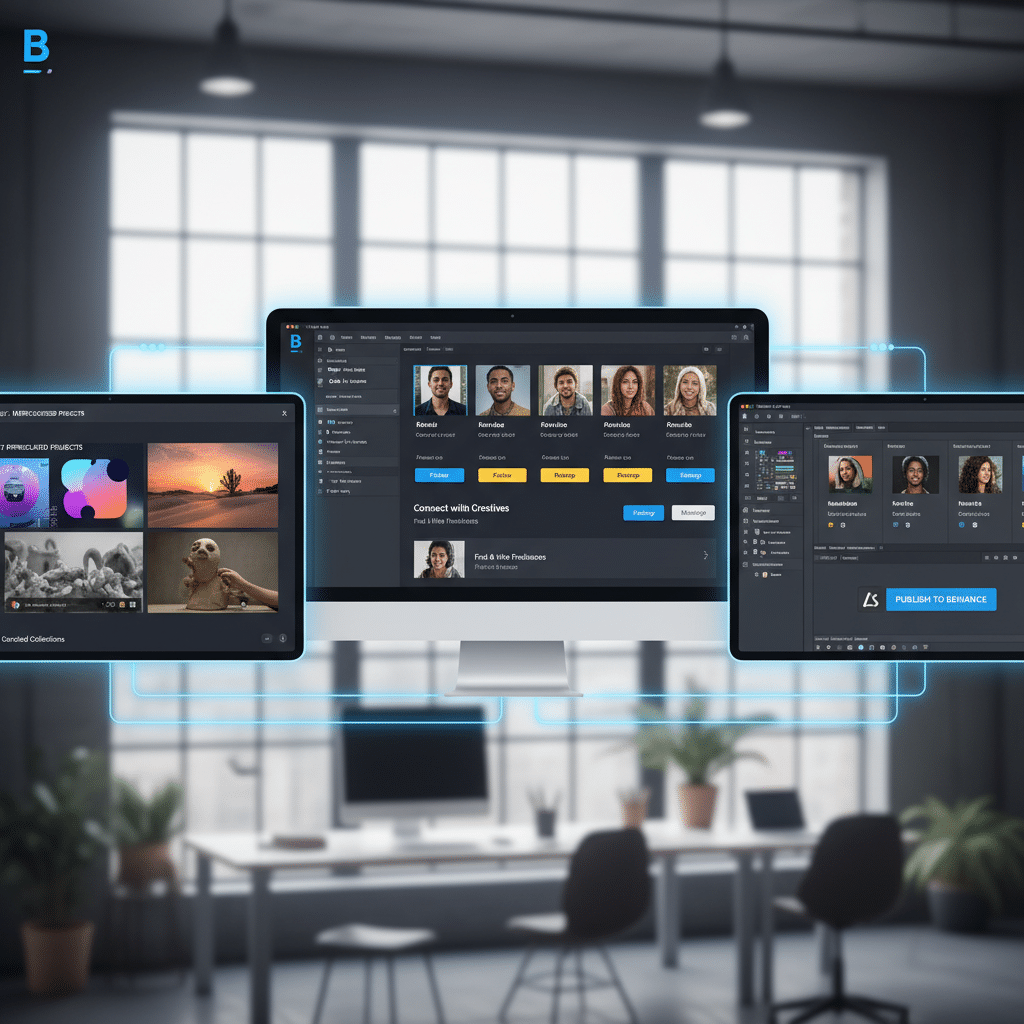
Cons
- Overwhelming volume of content: The sheer amount of projects can make it difficult for individual portfolios to stand out without active promotion.
- Locked features behind Pro: Some advanced visibility and account features require a Pro subscription, which limits access for free users.
- Variable quality control: Because it is an open platform, the quality of showcased work varies widely and may require time to sift through to find high-quality examples.
Who It’s For
Behance is ideal for creative professionals, freelancers, agencies, and companies seeking inspiration, collaboration, or talent. If you need a polished, image-first portfolio that ties into a large creative community—and you want a channel where clients and peers can discover and reach out—Behance fits that need.
Unique Value Proposition
Behance combines portfolio hosting, community discovery, and hiring pathways in one visual ecosystem, enhanced by Adobe integration. That combination makes it a go-to showcase for creatives who want visibility, community feedback, and direct access to potential clients.
Real World Use Case
A graphic designer publishes a curated series of projects on Behance, uses curated collections and tags to increase visibility, engages with feedback from peers, and receives direct inquiries from clients interested in freelance work.
Pricing
Free tier available; Pro accounts available for additional features and visibility options.
Website: https://behance.net
Dribbble
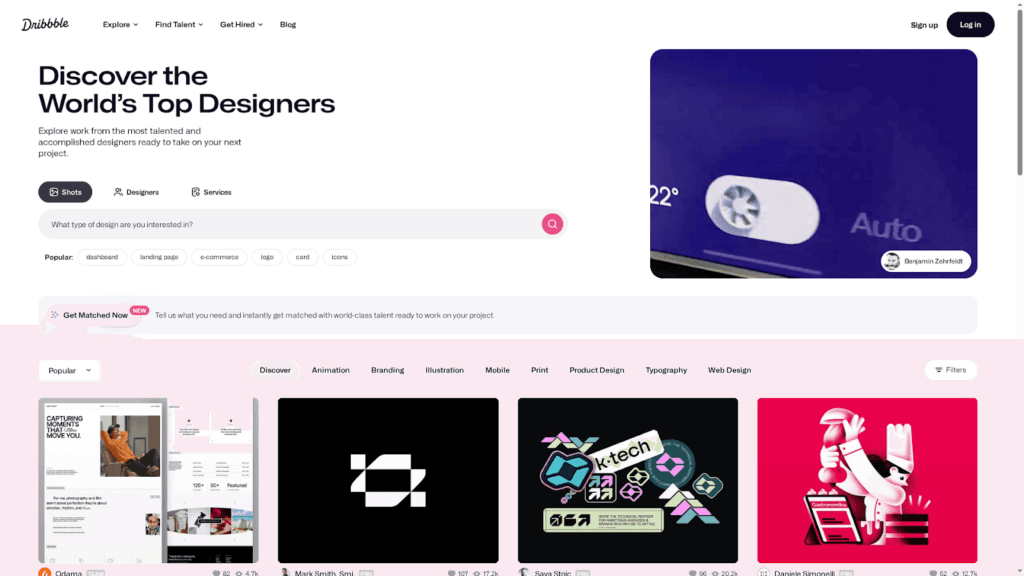
At a Glance
Dribbble is a showcase-and-hiring platform where top designers and creative professionals display work and connect with clients. It excels at discovery and matching, making it straightforward to browse portfolios across branding, web design, illustration, and animation. However, the public-facing information is light on pricing and service specifics, and competition for high-profile talent can be intense. Bottom line: great for inspiration and finding skilled designers quickly, but expect to dig deeper on costs and availability.
Core Features
Dribbble centers on visual discovery and talent matching. You can browse curated and user-submitted work, search and filter designers by tags, skills, and popularity, and sign up for a personalized experience. The platform also offers instant matching to connect companies with designers and development talent. In short: it combines a portfolio gallery with search tools and a matchmaking layer to speed hiring and talent discovery.
Pros
- Access to top-tier creative professionals: The platform highlights high-quality work, making it easier to find experienced designers and specialists.
- Easy matching process for hiring: Built-in matching features shorten the time between spotting talent and initiating a hire.
- Diverse range of design categories: You can explore many disciplines—from branding to animation—so niche needs are more likely to be met.
- Opportunity to showcase work and portfolio: Designers can use the platform to display projects that attract client interest and build reputation.
- Active community for inspiration and networking: Regular uploads and community interaction provide ongoing creative inspiration and potential collaboration opportunities.
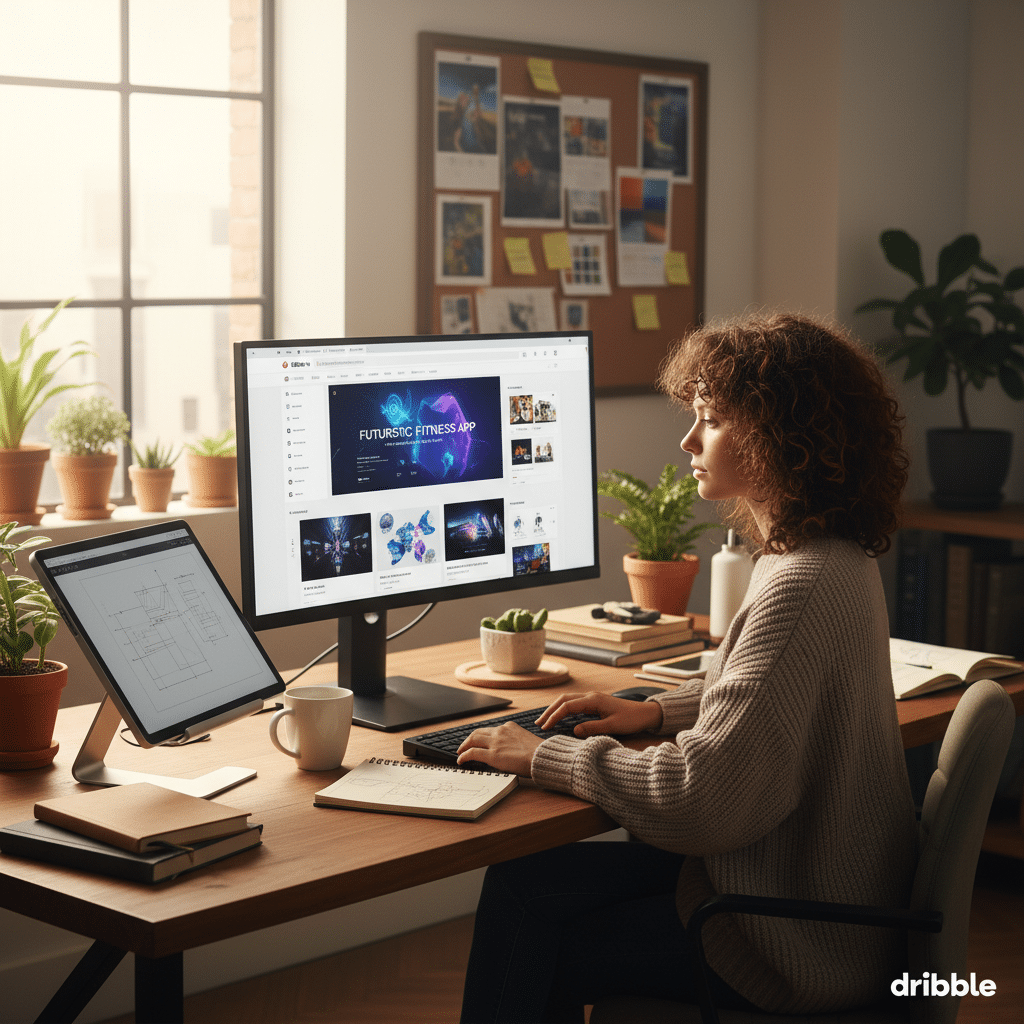
Cons
- Limited details on specific services and pricing in the content provided: Public information does not clarify pricing or package differences, which can slow decision-making.
- Potentially high competition for top designers: Standing out may be difficult for emerging creatives because top talent attracts most of the attention.
- Some features may require account creation or payment for full access: Full access to matching or premium features is not fully described, implying potential paywalls or gated tools.
Who It’s For
Dribbble is designed for businesses or individuals who need reliable access to vetted creative talent, and for designers who want to showcase portfolios to potential clients. If your goal is to discover trends, recruit experienced visual designers, or present polished project work to a professional audience, Dribbble fits those needs well.
Unique Value Proposition
Dribbble’s core strength is combining a high-visibility portfolio gallery with an instant matching capability—so you don’t just find beautiful work, you get routed toward the people who made it. That blend makes it particularly valuable for teams that want both inspiration and a fast path to hiring.
Real World Use Case
A startup uses Dribbble to locate a UI/UX designer: the team browses portfolios for relevant app interfaces, filters candidates by skills and tags, uses the platform’s matching feature to shortlist prospects, and then contacts the chosen designer to begin the project.
Pricing
Not specified in the provided content.
Website: https://dribbble.com
Creative Platforms Comparison
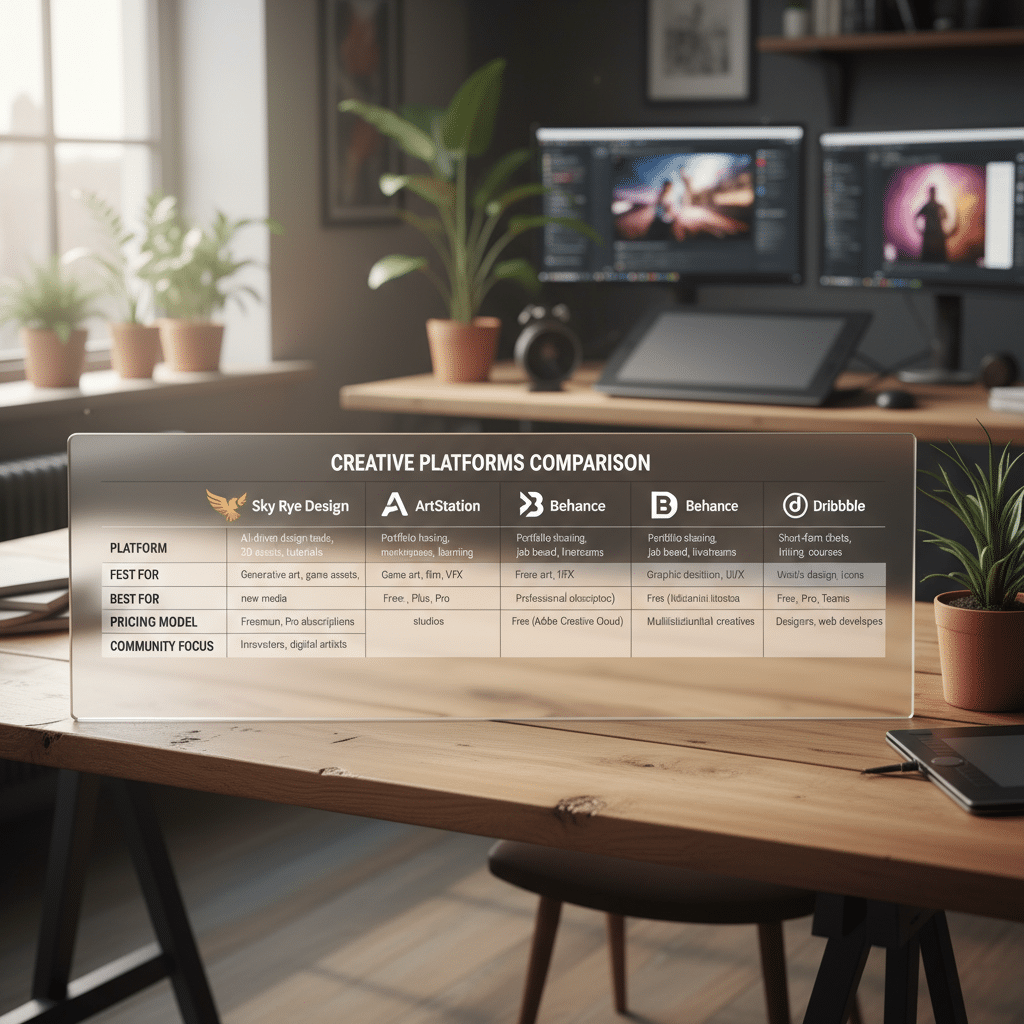
This table compares four platforms focused on creative expression, showcasing, and learning: Sky Rye Design, ArtStation, Behance, and Dribbble. Each offers unique features tailored to different artistic needs.
| Platform | Key Features | Pros | Cons | Pricing |
| Sky Rye Design | Curated art and design content; Regular updates; Tutorials for different skill levels | Wide topical range; Consistently refreshed content; Skill-level inclusivity | No direct sales or community tools | Not specified |
| ArtStation | Portfolio hosting and marketplace; Multiple sign-in options; Currency localization for international users | Popular for exposure; Marketplace plus event sales | Limited product detail; Possible regional restrictions | Not specified |
| Behance | Gallery-style portfolio presentation; Community discovery and feedback; Adobe Creative Cloud integration | Extensive creative network; Hiring and collaboration opportunities | Overwhelming content volume; Pro features locked | Free tier available; Pro for extras |
| Dribbble | Visual discovery and talent matching; Search and filter designers; Instant matching for hiring | Access to top-tier professionals; Easy hiring process; Active community | Limited service and pricing details; High competition for talent | Not specified |
Elevate Your Art Portfolio with Inspired Creative Guidance
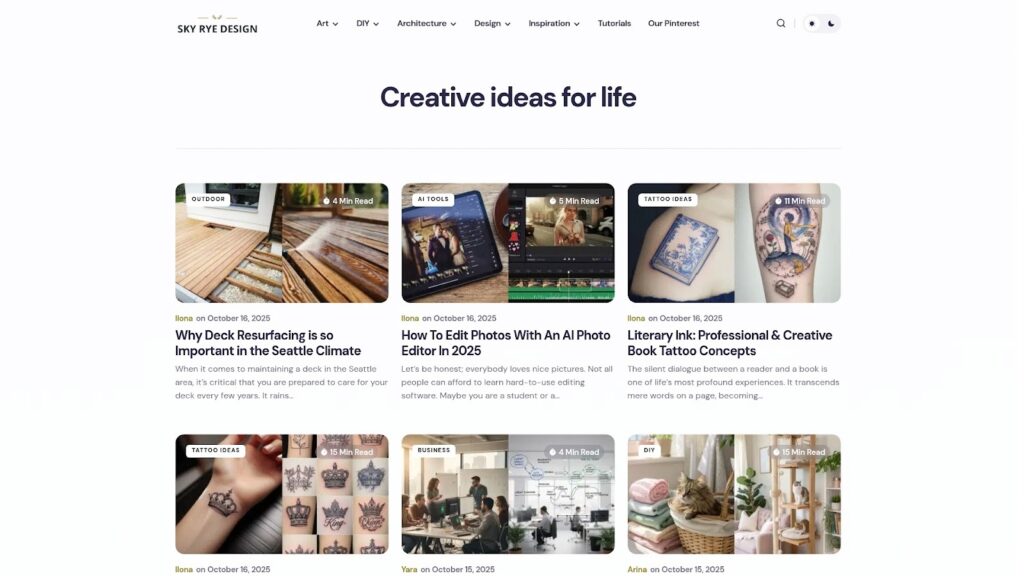
Choosing the right art portfolio website can feel overwhelming when you want your unique style to shine and your work to connect with the perfect audience. This expert comparison highlights the challenges of balancing portfolio visibility with sales opportunities and community engagement. You may be seeking clear creative direction, practical tutorials, or fresh ideas to make your portfolio stand out, all without the clutter of excessive marketplace noise.At Sky Rye Design, we understand this quest for authentic, skill-building content that fuels creativity across illustration, animation, and design. Explore our Illustration | Sky Rye Design and Animation | Sky Rye Design categories for step-by-step tutorials and inspiring projects crafted to help artists at every level build confidence and expand their portfolio strengths.
Looking to create a compelling UX or UI design that captivates clients? Our UX / UI | Sky Rye Design section offers thoughtfully curated insights to sharpen your visual storytelling skills.
Don’t let confusion slow your creative growth. Visit Sky Rye Design now to unlock a world of guidance designed to elevate your portfolio and bring your artistic vision to life. Start refining your craft today and set your work apart in 2025 and beyond.
Frequently Asked Questions

What are the main features to look for in an art portfolio website?
A great art portfolio website should offer gallery-style presentations, easy navigation, customizable templates, and options for project organization. Evaluate each platform to ensure it showcases your work effectively and provides an intuitive interface for potential clients.
How can I choose the best art portfolio website for my needs?
To choose the best art portfolio website, identify your primary goals—whether it’s showcasing your work, selling art, or connecting with clients. Compare features, such as e-commerce options or community engagement tools, to ensure the site aligns with your objectives.
What is the importance of community engagement on art portfolio websites?
Community engagement on art portfolio websites allows artists to network, receive feedback, and connect with potential clients. Seek platforms that facilitate interactions, showcase trending work, and promote collaboration for better visibility.
How often should I update my art portfolio on these websites?
Aim to update your art portfolio every 1-2 months with new projects or revisions to existing work. Regular updates not only keep your portfolio fresh but also show potential clients that you are active and engaged in your craft.
Can I use multiple art portfolio websites simultaneously?
Yes, using multiple art portfolio websites is a viable strategy to expand your reach and diversify your audience. Just ensure each platform serves a different purpose, such as one for showcasing your best work and another for selling prints or connecting with clients.
What analytics should I track on my art portfolio website?
Monitor key analytics like page views, engagement rates, and conversion rates to see how effectively your portfolio attracts and retains visitors. This data will help you refine your content and marketing strategies, leading to improved visibility and client interactions.
Recommended
- How to Curate an Authentic, Impactful Design Portfolio |
- Create a Stunning Fashion Design Portfolio That Stands Out
- Elevate Your Online Presence with Expert Web Design Tips
- 0shares
- Facebook0
- Pinterest0
- Twitter0


